Solar Eclipses on Earth, Mars, and Beyond
Li Mingming
April 7, 2024
Solar eclipse and earth. Solar eclipse, a mysterious natural phenomenon when the moon passes between the earth and the sun.
Image copyright©️
[New Sancai compilation first release]
On April 8, 2024, North America will witness the last total solar eclipse in more than two decades. Over the next decade, other parts of the world will experience this rare celestial event. A total solar eclipse occurs when the Moon passes directly between the Sun and Earth, the Sun's disk is obscured, and the corona is observed during a total solar eclipse. While a solar eclipse is spectacular when viewed from the ground, when viewed from space, it looks like a giant shadow moving across the Earth's surface. The unique geometry of the Earth-Sun-Moon system allows a total solar eclipse to occur. Solar eclipses also occur outside the Earth-Moon system, although the awe-inspiring sights produced by the geometry of these worlds are less common on Earth. These extraterrestrial eclipses have been recorded by spacecraft exploring other worlds.
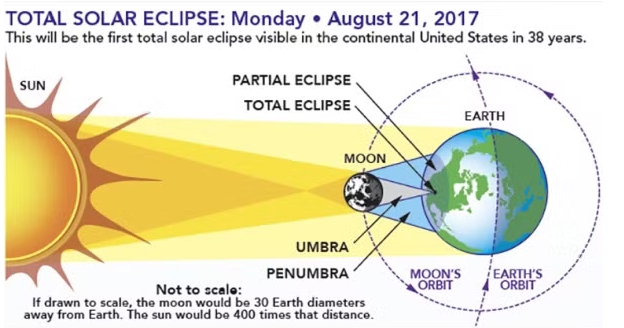
Left: Schematic geometry of a solar eclipse; dimensions and distances are not to scale. Right: The path of the total solar eclipse on April 8, 2024.
A solar eclipse occurs when the moon passes between the sun and the Earth, casting its shadow onto the Earth. Although the sun is much larger than the moon, it is also much further away. The Sun and Moon have approximately the same angular diameter as seen from Earth and are approximately the same size in the sky. A total solar eclipse occurs when the moon completely blocks the sun. Because the Moon does not orbit the Earth perfectly, it appears smaller at its farthest point, creating an annular solar eclipse. Moons around other planets may also produce eclipses, although their different sizes relative to the Sun do not produce the solar eclipses we are familiar with. Planets with multiple moons may experience more than one eclipse at the same time.

Left: In November 1966, Gemini 12 astronauts photographed a total solar eclipse from Earth orbit. Center: In April 1967, Surveyor 3 observed a total solar eclipse from the moon. Right: In November 1969, the Apollo 12 astronauts experienced a solar eclipse while returning from the moon. Shortly before splashdown, Earth blocked the sun.
Gemini 12 astronauts James A. Lovell and Edwin E. “Buzz” Aldrin on November 12, 1966 A solar eclipse was photographed from Earth orbit for the first time. After 16 hours of flight, they saw an almost total solar eclipse as they flew over the Earth. Galapagos and Aldrin captured several photos and a short video. Calculations show that Gemini 12 passed within 3.4 miles of the center of the eclipse's path in South America. On April 24, 1967, the Surveyor 3 spacecraft observed a solar eclipse on the moon for the first time. Unlike solar eclipses observed from Earth, this time the Earth itself blocks the Sun—when the moon passes through the Earth's shadow, observers on Earth see the event as a lunar eclipse. In November 1969, as Apollo 12 astronauts Charles "Pete" Conrad, Richard F. Gordon and Alan L. Bean returned from the second moon landing and approached Earth, Surveyor 3 - Orbit Mechanics had a show for them. Their tracks passed through Earth's shadow, and a total solar eclipse was seen. From their perspective, the Earth is about 15 times larger than the Sun. Gordon reported via radio to mission control, "We saw something spectacular during the eclipse," and Bean declared it a "wonderful sight." Conrad reported on the rapidly changing scenery, with the sun lighting up the Earth's atmosphere in a 360-degree circle, changing colors, while the Earth remained pitch black. In the darkness, they could see lightning appearing like fireflies in a thunderstorm. As their eyes adjusted to the dark parts of the Earth, they saw landmasses like India, and even city lights. They reported seeing a large bright circle in the center of Earth's dark disk, which turned out to be light reflected from the Indian Ocean by the full moon.
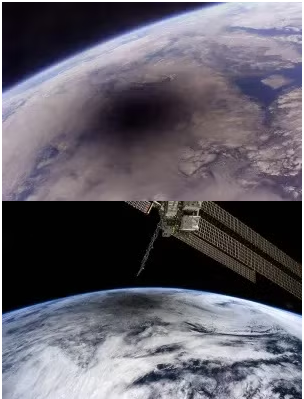
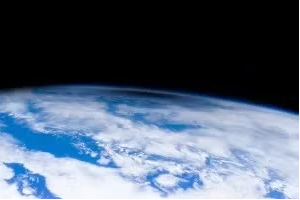
Top: The Moon's shadow captured from the Mir Space Telescope during the August 1999 lunar eclipse. Image source: Provided by French space agency CNES. Center: NASA astronaut Donald R. Pettit observed the first solar eclipse from the International Space Station aboard Expedition 6 in December 2002. Bottom: Pettit observed the second solar eclipse aboard Expedition 31 in May 2012.
That honor belongs to French astronaut Jean-Pierre Haigneré, who took the first photo of the Moon's shadow from Earth orbit during a solar eclipse. On August 11, 1999, as the Expedition 27 flight engineer, he took photos of the total solar eclipse passing over the United Kingdom on the Russian Mir space station. NASA astronaut Donald R. Pettit claimed to be the first person to photograph a solar eclipse from the International Space Station. He observed a total solar eclipse on Expedition 6 on December 2, 2002. . As an additional statement, on May 20, 2012, Pettit observed his second solar eclipse, this time an annular eclipse over the Western Pacific, while aboard the Expedition 31 space station.

Left: Image of a total solar eclipse in the eastern Mediterranean taken by Expedition 12 in March 2006. Center: Image of a total solar eclipse in North America taken by Expedition 52 in August 2017. Right: Image of an annular solar eclipse taken by Yuanzheng 63 in June 2020.

Left and center: Two images of the December 2021 solar eclipse over Antarctica, from the Expedition 66 crew (left) and the Deep Space Climate Observatory (DSCOVR) satellite aboard the space station. Right: DSCOVR image of the October 2023 annular solar eclipse over North America.
In addition to Pettit's two sightings, many solar eclipses were observed and recorded by space station staff, who were able to see the moon's shadow as it crossed the Earth's surface, determined by its orbital path. Expedition 12 observed a total solar eclipse on March 29, 2006, Expedition 43 observed a total solar eclipse on March 25, 2015, and Expedition 52 observed the latest total solar eclipse visible from North America on August 21, 2017. , Expedition 61 observed an annular solar eclipse on August 21, 2017. On December 26, 2019 and June 21, 2020, Expedition 63 observed annular solar eclipses. On December 4, 2021, Expedition 66 photographed a total solar eclipse over Antarctica. On October 14, 2023, Expedition 66 An annular solar eclipse was observed in North America on the 70th. Nearly a million miles away at the L1 Earth-Sun Lagrangian point, NOAA's Deep Space Climate Observatory (DSCOVR) satellite keeps a close eye on Earth's climate. The camera and telescope on DSCOVR, NASA's Earth Polychromatic Imaging Camera (EPIC), captured stunning images of the moon's shadow as it passed across the Earth's surface during a solar eclipse.
Mars
Outside the Earth-Moon system, solar eclipses do not occur on Mercury and Venus, which lack natural satellites to obscure the Sun. Mars has two small moons: Phobos and Deimos, which appear to be only half the size of Earth. They are both too small to completely obscure the sun. Several detectors captured an annular solar eclipse of Phobos and Deimos. Some astronomers believe that due to the small size of the Martian moons, especially Deimos, compared to the Sun, these moons are technically transits rather than eclipses, but there is no formal definition. Shortly after arriving on Mars, the Opportunity rover photographed the first solar eclipses on the surface of Mars, first of Deimos on March 4, 2004, and of Phobos three days later. Most recently, the Perseverance Mars 2000 rover captured an annular solar eclipse of Phobos on April 20, 2022, and a solar eclipse (or transit) of Deimos on January 22, 2024. }

Left: Image taken by the Opportunity Mars rover of Deimos (left) and Phobos passing in front of the Sun. Center: Perseverance captured an image of the annular eclipse of Phobos in April 2022. Right: Perseverance captured images of the January 2024 solar eclipse (or transit) of Deimos.
Jupiter
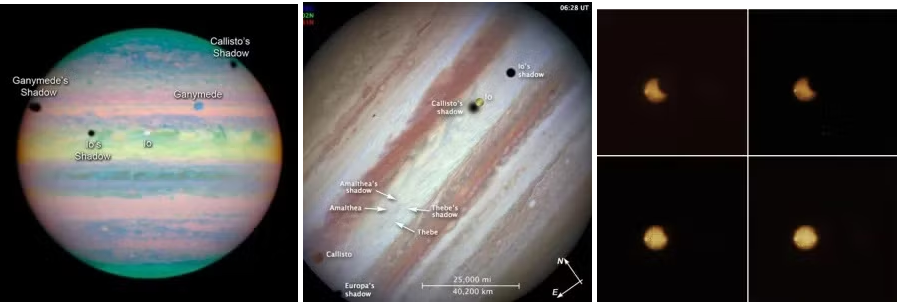
Left: Infrared image of a triple solar eclipse of Jupiter taken by the Hubble Space Telescope on March 28, 2004, showing the shadows of the moons Ganymede, Io and Callisto on Jupiter. Center: Image of multiple eclipses of Jupiter taken by the Hubble Space Telescope on January 24, 2015. Jupiter's five moons - Callisto, Io, Europa, Amalthea and Thebe - in Shadow on Jupiter. Right: Europa's eclipse of Io as seen through an Earth-based telescope in December 2014.
Because the gas giant planet has no solid surface on its outer layer, the spacecraft did not capture an actual eclipse image from any of the many satellites orbiting the planet. Through ground-based and orbiting telescopes and spacecraft, we can observe the shadows cast by satellites on their parent planets. Solar eclipses are not uncommon on Jupiter because of its large size compared to many of its moons and its distance from the sun. Among Jupiter's moons, only five - Amalthea, Io, Europa, Ganymede, and Callisto - are large enough or close enough to Jupiter to completely obscure the sun. Because of the low inclination of the satellite's orbit, each rotation creates a shadow. It is not uncommon for two, three, and multiple solar eclipses to occur simultaneously. The Hubble Space Telescope observed many of these events. Considering the number of Jupiter's moons, especially the four large Galilean moons, all orbiting very close to Jupiter's equatorial plane, they will occasionally eclipse each other, with the outer moons passing between the sun and the inner moons. Lucky observers using ground-based telescopes can capture these rare images as the Earth crosses the equatorial plane of Jupiter, sometimes seen accidentally when observing the Galilean moons.

Left: In September 2019, Juno captured an image of Io's shadow on Jupiter. Right: In February 2022, Juno captured an image of Ganymede casting its shadow on Jupiter.
The Juno spacecraft has been orbiting Jupiter since 2016, sending back stunning images of Jupiter's clouds. A spectacular image of the shadow of Io on Jupiter's colorful cloud tops was captured on September 11, 2019. On February 25, 2022, Juno photographed the shadow of the largest moon Ganymede.
Saturn and beyond
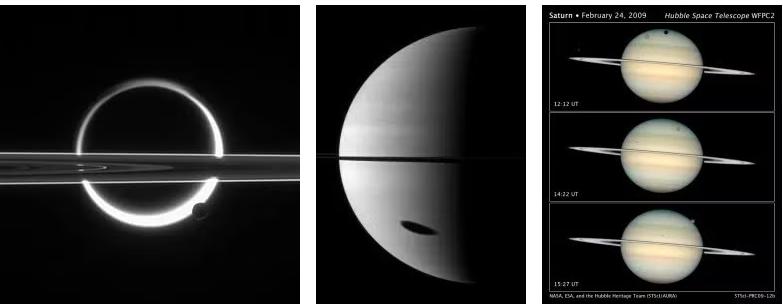
Left: In November 2009, while orbiting Saturn, Cassini captured a solar eclipse image of the moons Titan (center), Enceladus (lower right of Titan), and the planet's rings. Center: The shadow of the moon Titan on Saturn elongated by the planet's curvature, as captured by the Cassini spacecraft in November 2009. Right: Images of four solar eclipses taken by the Hubble Space Telescope in February 2009, showing the shadows of Saturn's moons Enceladus, Enceladus, Titan and Mimas on Saturn.
Like Jupiter, dozens of moons orbit Saturn, and telescopes and spacecraft can fully observe the moons passing in front of Saturn and casting their shadows on Saturn. The Cassini spacecraft orbited Saturn between 2004 and 2017, taking thousands of images of Saturn, its rings and moons. Cassini passed behind the planet and its moons multiple times, causing artificial eclipses, while at other times the spacecraft photographed the moons' shadows above the planet's cloud tops. On February 24, 2009, when Saturn's moons Enceladus, Enceladus, Titan and Mimas passed by Saturn, they cast their shadows on the cloud tops. The Hubble Space Telescope captured a series of rare images of a quadruple solar eclipse.
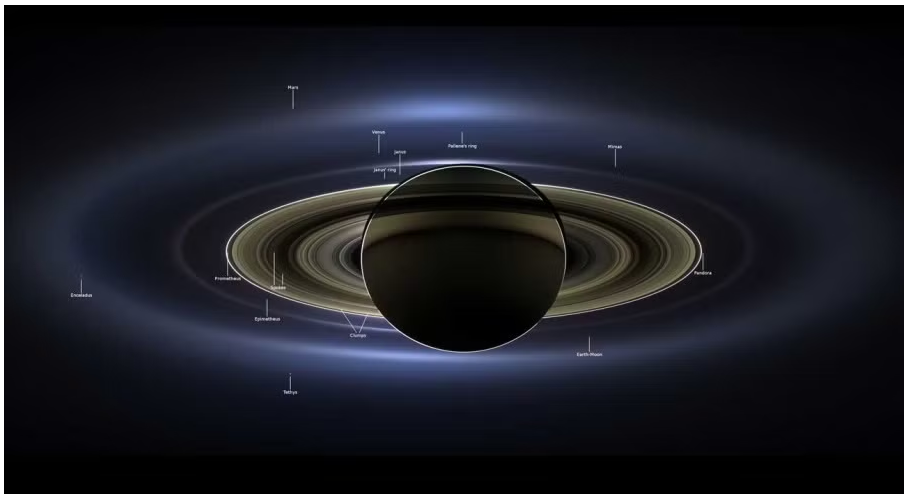
In November 2013, the Cassini spacecraft created this artificial Saturnian solar eclipse as it flew past Saturn in one of its orbits, and it was visible to many celestial bodies, including Earth.
On July 19, 2013, when Saturn obscured the sun, Cassini captured a series of images from a distance of about 750,000 miles. In the "Earth Smile Day" event, people on Earth were notified in advance that Cassini would take photos from 900 million miles away and were encouraged to smile at its camera. In addition to the Earth and Moon, Cassini captured seven moons of Venus, Mars and Saturn in photos.
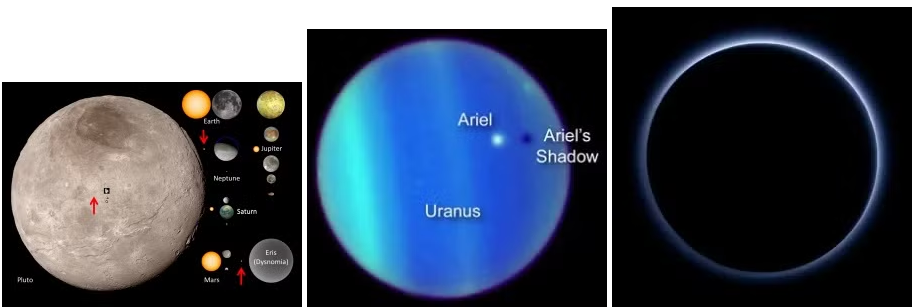
Left: Composite image showing the relative apparent sizes of the Sun and a series of planetary satellites. Image source: provided by sdoisgo.blogspot.com. Center: In July 2006, the Hubble Space Telescope imaged the shadows cast by Uranus and its moon Ariel on Earth. Right: In July 2015, the New Horizons spacecraft produced an artificial solar eclipse as it flew by Pluto, with the sun's rays highlighting its thin atmosphere.
The Earth occupies a unique position where the apparent diameters of the Moon and Sun are nearly equal, providing opportunities for annular and total solar eclipses. The apparent diameter of the Sun decreases when viewed from planets further out in the solar system, and the apparent sizes of satellites orbiting these planets are either larger or smaller than the Sun. Solar eclipses as we know them do not exist elsewhere in the solar system. Spacecraft exploring these distant worlds can easily create artificial eclipses by crossing the planet's shadow, often revealing important information, such as New Horizons' images of the thin atmosphere surrounding Pluto.
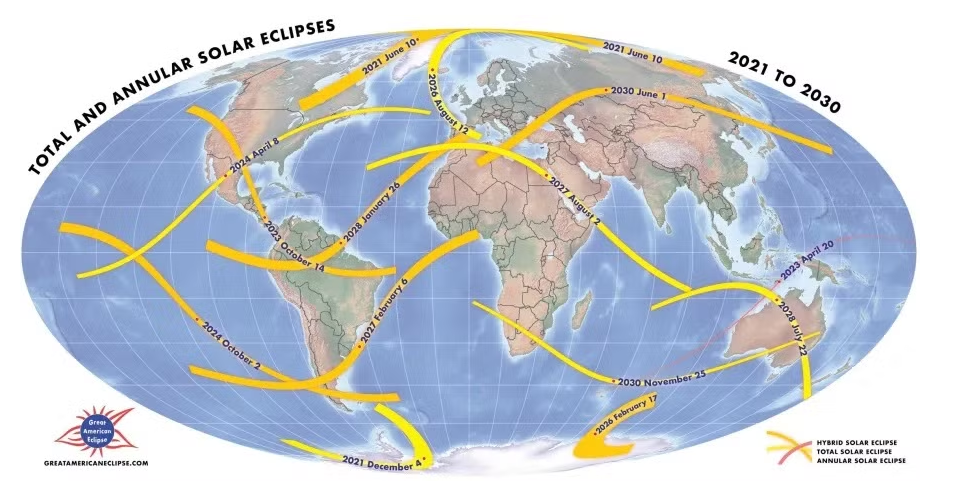
Solar eclipse path from 2021 to 2030.
The next total solar eclipse won't be visible in North America until 2044, but over the next few years, several total solar eclipses visible in other parts of the world will be the target of astronaut cameras aboard the space station. Spacecraft exploring the solar system's planets will continue to record eclipses in those distant places.
(Compiled by: Li Mingming)
(Editor: Jiang Qiming)
(Source of the article: Compiled and published by New Sancai)
